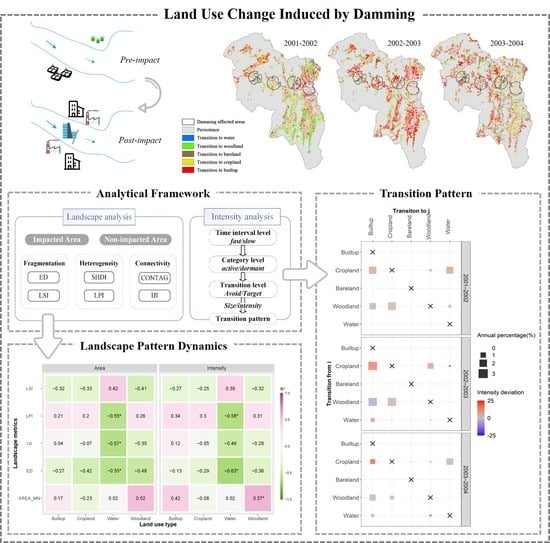Linking Land Cover Change with Landscape Pattern Dynamics Induced by Damming in a Small Watershed
Abstract
:1. Introduction
2. Materials and Methods
2.1. Study Area
2.2. Data Collection and Processing
2.3. Enhanced Intensity Analysis
2.4. Landscape Pattern Index
3. Results
3.1. Overall Land Cover Changes
3.2. Change Analysis
3.3. Landscape Analysis
3.4. Relationship between the Intensity of Land Use Changes and Landscape Pattern Dynamics Induced by Damming
4. Discussion
4.1. Effectiveness of the Proposed Framework in a Small Headwater Watershed
4.2. Linking Land Cover Change with Landscape Pattern Dynamics Induced by Damming
4.3. Implications for Land Management
5. Conclusions
Supplementary Materials
Author Contributions
Funding
Data Availability Statement
Conflicts of Interest
References
- Grill, G.; Lehner, B.; Thieme, M.; Geenen, B.; Tickner, D.; Antonelli, F.; Babu, S.; Borrelli, P.; Cheng, L.; Crochetiere, H.; et al. Mapping the world’s free-flowing rivers. Nature 2019, 569, 215–221. [Google Scholar] [CrossRef] [PubMed]
- Barbarossa, V.; Schmitt, R.J.P.; Huijbregts, M.A.J.; Zarfl, C.; King, H.; Schipper, A.M. Impacts of current and future large dams on the geographic range connectivity of freshwater fish worldwide. Proc. Natl. Acad. Sci. USA 2020, 117, 3648–3655. [Google Scholar] [CrossRef] [PubMed] [Green Version]
- Maavara, T.; Akbarzadeh, Z.; Van Cappellen, P. Global dam-driven changes to riverine N:P:si ratios delivered to the coastal ocean. Geophys. Res. Lett. 2020, 47, e2020. [Google Scholar] [CrossRef]
- Zhang, Z.; Liu, J.; Huang, J. Hydrologic impacts of cascade dams in a small headwater watershed under climate variability. J. Hydrol. 2020, 590, 125426. [Google Scholar] [CrossRef]
- Ouyang, W.; Hao, F.; Song, K.; Zhang, X. Cascade dam-induced hydrological disturbance and environmental impact in the upper stream of the Yellow River. Water Resour. Manag. 2011, 25, 913–927. [Google Scholar] [CrossRef]
- Li, K.; Zhu, C.; Wu, L.; Huang, L. Problems caused by the Three Gorges Dam construction in the Yangtze River basin: A review. Environ. Rev. 2013, 21, 127–135. [Google Scholar] [CrossRef]
- Li, Y.; Hu, J.; Han, X.; Li, Y.; Li, Y.; He, B.; Duan, X. Effects of past land use on soil organic carbon changes after dam construction. Sci. Total Environ. 2019, 686, 838–846. [Google Scholar] [CrossRef]
- Yang, J.; Shi, F.; Sun, Y.; Zhu, J. A cellular automata model constrained by spatiotemporal heterogeneity of the urban development strategy for simulating land use change: A Case study in Nanjing City, China. Sustainability 2019, 11, 4012. [Google Scholar] [CrossRef] [Green Version]
- Calvi, M.F.; Moran, E.F.; da Silva, R.F.B.; Batistella, M. The construction of the Belo Monte dam in the Brazilian Amazon and its consequences on regional rural labor. Land Use Policy 2020, 90, 104327. [Google Scholar] [CrossRef]
- Liu, Y.; Yang, W.; Yu, Z.; Lung, I.; Yarotski, J.; Elliott, J.; Tiessen, K. Assessing effects of small dams on stream flow and water quality in an agricultural watershed. J. Hydrol. Eng. 2014, 19, 5014015. [Google Scholar] [CrossRef]
- Bhatti, N.B.; Siyal, A.A.; Qureshi, A.L.; Bhatti, I.A. Land covers change assessment after small Dam’s construction based on the satellite data. Civ. Eng. J. 2019, 5, 810–818. [Google Scholar] [CrossRef] [Green Version]
- Turner, B.L.; Robbins, P. Land-change science and political ecology: Similarities, differences, and implications for sustainability science. Annu. Rev. Environ. Resour. 2008, 33, 295–316. [Google Scholar] [CrossRef]
- Alturk, B.; Konukcu, F. Modeling land use/land cover change and mapping morphological fragmentation of agricultural lands in Thrace Region/Turkey. Environ. Dev. Sustain. 2020, 22, 6379–6404. [Google Scholar] [CrossRef]
- Lambin, E.F.; Meyfroidt, P. Global land use change, economic globalization, and the looming land scarcity. Proc. Natl. Acad. Sci. USA 2011, 108, 3465–3472. [Google Scholar] [CrossRef] [Green Version]
- IPCC. Climate Change, Desertification, Land Degradation, Sustainable Land Management, Food Security, and Greenhouse Gas Fluxes in Terrestrial Ecosystems; Cambridge University Press: London, UK, 2019. [Google Scholar]
- Xie, Z.; Pontius, R.G., Jr.; Huang, J.; Nitivattananon, V. Enhanced intensity analysis to quantify categorical change and to identify suspicious land transitions: A Case study of Nanchang, China. Remote Sens. 2020, 12, 3323. [Google Scholar] [CrossRef]
- Jiang, X.; Lu, D.; Moran, E.; Calvi, M.F.; Dutra, L.V.; Li, G. Examining impacts of the Belo Monte hydroelectric dam construction on land cover changes using multitemporal Landsat imagery. Appl. Geogr. 2018, 97, 35–47. [Google Scholar] [CrossRef]
- Eekhout, J.P.C.; Boix-Fayos, C.; Pérez-Cutillas, P.; de Vente, J. The impact of reservoir construction and changes in land use and climate on ecosystem services in a large Mediterranean catchment. J. Hydrol. 2020, 590, 125208. [Google Scholar] [CrossRef]
- Nnaji, C.C.; Ogarekpe, N.M.; Nwankwo, E.J. Temporal and spatial dynamics of land use and land cover changes in derived savannah hydrological basin of Enugu State, Nigeria. Environ. Dev. Sustain. 2022, 24, 9598–9622. [Google Scholar] [CrossRef]
- Rodrigues, L.N.; Sano, E.E.; Steenhuis, T.S.; Passo, D.P. Estimation of small reservoir storage capacities with remote sensing in the Brazilian savannah region. Water Resour. Manag. 2012, 26, 873–882. [Google Scholar] [CrossRef]
- Cho, M.S.; Qi, J. Quantifying spatiotemporal impacts of hydro-dams on land use/land cover changes in the Lower Mekong River Basin. Appl. Geogr. 2021, 136, 102588. [Google Scholar] [CrossRef]
- Chen, X.; Wang, Y.; Cai, Z.; Zhang, M.; Ye, C. Response of the nitrogen load and its driving forces in estuarine water to dam construction in Taihu Lake, China. Environ. Sci. Pollut. Res. Int. 2020, 27, 31458–31467. [Google Scholar] [CrossRef]
- McFeeters, S.K. The use of the Normalized Difference Water Index (NDWI) in the delineation of open water features. Int. J. Remote Sens. 1996, 17, 1425–1432. [Google Scholar] [CrossRef]
- Xu, H. Modification of normalised difference water index (NDWI) to enhance open water features in remotely sensed imagery. Int. J. Remote Sens. 2006, 27, 3025–3033. [Google Scholar] [CrossRef]
- Luo, J.; Sheng, Y.; Shen, Z.; Li, J.; Gao, L. Automatic and high-precise extraction for water information from multispectral images with the step-by-step iterative transformation mechanism Automatic and high-precise extraction for water information from multispectral images with the step-by-step iterative transformation mechanism. J. Remote Sens. 2009, 13, 610–615. [Google Scholar]
- Yang, S.; Xue, C.; Liu, T.; Li, Y. A method of small water information automatic extraction from TM remote sensing images. Acta Geod. Cartogr. Sin. 2010, 39, 611–617. [Google Scholar]
- Du, J.; Huang, Y.; Feng, X.; Wang, Z. Study on water bodies extraction and classification from SPOT image. J. Remote Sens. 2001, 5, 214–219. [Google Scholar]
- Deng, J.; Wang, K.; Li, J.; Dong, Y. Study on the automatic extraction of water body informat ion from SPOT-5 images using decision tree algorithm. J. Zhejiang Univ. (Agric. Life Sci.) 2005, 31, 171–174. [Google Scholar]
- Zheng, C.; Wang, X.; Huang, J. Decision tree algorithm of automatically extracting paddy rice Information 5from SPOT-5 Images Based on Characteristic Bands. Remote Sens. Technol. Appl. 2008, 23, 294–299. [Google Scholar]
- Wei, X.; Sauvage, S.; Ouillon, S.; Le, T.P.Q.; Orange, D.; Herrmann, M.; Sanchez-Perez, J.-M. A modelling-based assessment of suspended sediment transport related to new damming in the Red River basin from 2000 to 2013. CATENA 2021, 197, 104958. [Google Scholar] [CrossRef]
- Versace, V.L.; Ierodiaconou, D.; Stagnitti, F.; Hamilton, A.J. Appraisal of random and systematic land cover transitions for regional water balance and revegetation strategies. Agric. Ecosyst. Environ. 2008, 123, 328–336. [Google Scholar] [CrossRef]
- Shoyama, K.; Braimoh, A.K. Analyzing about sixty years of land cover change and associated landscape fragmentation in Shiretoko Peninsula, Northern Japan. Landsc. Urban Plan. 2011, 101, 22–29. [Google Scholar] [CrossRef]
- Romero-Ruiz, M.H.; Flantua, S.G.A.; Tansey, K.; Berrio, J.C. Landscape transformations in savannas of northern South America: Land use/cover changes since 1987 in the Llanos Orientales of Colombia. Appl. Geogr. 2012, 32, 766–776. [Google Scholar] [CrossRef]
- Quan, B.; Pontius, R.G., Jr.; Song, H. Intensity Analysis to communicate land change during three time intervals in two regions of Quanzhou City, China. Remote Sens. 2020, 57, 21–36. [Google Scholar] [CrossRef]
- Pontius, R.G., Jr.; Gao, Y.; Giner, N.M.; Kohyama, T.; Osaki, M.; Hirose, K. Design and interpretation of intensity analysis illustrated by land change in Central Kalimantan, Indonesia. Land 2013, 2, 351–369. [Google Scholar] [CrossRef]
- Zhou, P.; Huang, J.; Pontius, R.G., Jr.; Hong, H. Land classification and change intensity analysis in a coastal watershed of Southeast China. Sensors 2014, 14, 11640–11658. [Google Scholar] [CrossRef] [Green Version]
- Huang, J.; Pontius, R.G., Jr.; Li, Q.; Zhang, Y. Use of intensity analysis to link patterns with processes of land change from 1986 to 2007 in a coastal watershed of southeast China. Appl. Geogr. 2012, 34, 371–384. [Google Scholar] [CrossRef]
- Renetzeder, C.; Schindler, S.; Peterseil, J.; Prinz, M.A.; Mücher, S.; Wrbka, T. Can we measure ecological sustainability? Landscape pattern as an indicator for naturalness and land use intensity at regional, national and European level. Ecol. Indic. 2010, 10, 39–48. [Google Scholar] [CrossRef]
- Estoque, R.C.; Murayama, Y. Quantifying landscape pattern and ecosystem service value changes in four rapidly urbanizing hill stations of Southeast Asia. Landsc. Ecol. 2016, 31, 1481–1507. [Google Scholar] [CrossRef]
- Kienast, F.; Frick, J.; van Strien, M.J.; Hunziker, M. The Swiss Landscape Monitoring Program—A comprehensive indicator set to measure landscape change. Ecol. Modell. 2015, 295, 136–150. [Google Scholar] [CrossRef]
- Wan, L.; Zhang, Y.; Zhang, X.; Qi, S.; Na, X. Comparison of land use/land cover change and landscape patterns in Honghe National Nature Reserve and the surrounding Jiansanjiang Region, China. Ecol. Indic. 2015, 51, 205–214. [Google Scholar] [CrossRef]
- Cao, K. Spatial-temporal dynamics analysis of coastal landscape pattern on driving force of human activities: A case in south Yingkou, China. Appl. Ecol. Environ. Res. 2017, 15, 923–937. [Google Scholar] [CrossRef]
- Huang, J.; Huang, Y.; Pontius, R.G.; Zhang, Z. Geographically weighted regression to measure spatial variations in correlations between water pollution versus land use in a coastal watershed. Ocean Coast. Manag. 2015, 103, 14–24. [Google Scholar] [CrossRef]
- Huang, J.; Zhang, Z.; Feng, Y.; Hong, H. Hydrologic response to climate change and human activities in a subtropical coastal watershed of southeast China. Reg. Environ. Chang. 2013, 13, 1195–1210. [Google Scholar] [CrossRef]
- Zhang, Z.; Huang, J.; Huang, Y.; Hong, H. Streamflow variability response to climate change and cascade dams development in a coastal China watershed. Coast. Shelf Sci. 2015, 166, 209–217. [Google Scholar] [CrossRef]
- Lu, W.; Lei, H.; Yang, D.; Tang, L.; Miao, Q. Quantifying the impacts of small dam construction on hydrological alterations in the Jiulong River basin of Southeast China. J. Hydrol. 2018, 567, 382–392. [Google Scholar] [CrossRef]
- Teixeira, Z.; Marques, J.C.; Pontius, R.G. Evidence for deviations from uniform changes in a Portuguese watershed illustrated by CORINE maps: An Intensity Analysis approach. Ecol. Indic. 2016, 66, 382–390. [Google Scholar] [CrossRef] [Green Version]
- Shafizadeh-Moghadam, H.; Minaei, M.; Feng, Y.; Pontius, R.G., Jr. GlobeLand30 maps show four times larger gross than net land change from 2000 to 2010 in Asia. Int. J. Appl. Earth Obs. Geoinf. 2019, 78, 240–248. [Google Scholar] [CrossRef]
- Aldwaik, S.Z.; Pontius, R.G., Jr. Intensity analysis to unify measurements of size and stationarity of land changes by interval, category, and transition. Landsc. Urban Plan. 2012, 106, 103–114. [Google Scholar] [CrossRef]
- Chen, Z.; Wang, J. Land use and land cover change detection using satellite remote sensing techniques in the mountainous Three Gorges Area, China. Int. J. Remote Sens. 2010, 31, 1519–1542. [Google Scholar] [CrossRef]
- Iwuji, M.C.; Iheanyichukwu, C.P.; Njoku, J.D.; Okpiliya, F.I.; Anyanwu, S.O.; Amangabara, G.T.; Ukaegbu, K.O.E. Assessment of land use changes and impacts of dam construction on the Mbaa River, Ikeduru, Nigeria. JGEESI 2017, 13, 1–10. [Google Scholar] [CrossRef]
- Tang, J.; Li, Y.; Cui, S.; Xu, L.; Ding, S.; Nie, W. Linking land use change, landscape patterns, and ecosystem services in a coastal watershed of southeastern China. Glob. Ecol. Conserv. 2020, 23, e01177. [Google Scholar] [CrossRef]
- Yu, Q.; Hu, Q.; van Vliet, J.; Verburg, P.H.; Wu, W. GlobeLand30 shows little cropland area loss but greater fragmentation in China. Int. J. Appl. Earth Obs. Geoinf. ITC J. 2018, 66, 37–45. [Google Scholar] [CrossRef]
- Huang, B.; Huang, J.; Gilmore Pontius, R.G., Jr.; Tu, Z. Comparison of Intensity Analysis and the land use dynamic degrees to measure land changes outside versus inside the coastal zone of Longhai, China. Ecol. Indic. 2018, 89, 336–347. [Google Scholar] [CrossRef]
- Pontius, R.G., Jr. Component intensities to relate difference by category with difference overall. Int. J. Appl. Earth Obs. Geoinf. 2019, 77, 94–99. [Google Scholar] [CrossRef]
- Zhao, Q.; Liu, S.; Deng, L.; Dong, S.; Cong, W.; Wang, Z.; Yang, Z.; Yang, J. Landscape change and hydrologic alteration associated with dam construction. Int. J. Appl. Earth Obs. Geoinf. 2012, 16, 17–26. [Google Scholar] [CrossRef]
- Su, S.; Ma, X.; Xiao, R. Agricultural landscape pattern changes in response to urbanization at ecoregional scale. Ecol. Indic. 2014, 40, 10–18. [Google Scholar] [CrossRef]
- Abdullah, A.Y.M.; Masrur, A.; Adnan, M.S.G.; Baky, M.A.A.; Hassan, Q.K.; Dewan, A. Spatio-temporal patterns of land use/land cover change in the heterogeneous coastal region of Bangladesh between 1990 and 2017. Remote Sens. 2019, 11, 790. [Google Scholar] [CrossRef] [Green Version]
- Fearnside, P.M. Environmental and social impacts of hydroelectric dams in Brazilian Amazonia: Implications for the aluminum industry. World Dev. 2016, 77, 48–65. [Google Scholar] [CrossRef]
- Lupinacci, C.M.; da Conceição, F.T.; Heck Simon, A.L.; Perez Filho, A. Land use changes due to energy policy as a determining factor for morphological processes in fluvial systems in São Paulo State, Brazil. Earth Surf. Process. Landforms 2017, 42, 2402–2413. [Google Scholar] [CrossRef]
- Tao, Y.; Wang, H.; Ou, W.; Guo, J. A land cover-based approach to assessing ecosystem services supply and demand dynamics in the rapidly urbanizing Yangtze River Delta region. Land Use Policy 2018, 72, 250–258. [Google Scholar] [CrossRef]
- Cheng, L.; Brown, G.; Liu, Y.; Searle, G. An evaluation of contemporary China’s land use policy—The Link Policy: A case study from Ezhou, Hubei Province. Land Use Policy 2020, 91, 104423. [Google Scholar] [CrossRef]
- Liu, Y.; Fang, F.; Li, Y. Key issues of land use in China and implications for policy making. Land Use Policy 2014, 40, 6–12. [Google Scholar] [CrossRef]
- Castello, L.; Macedo, M.N. Large-scale degradation of Amazonian freshwater ecosystems. Glob. Chang. Biol. 2016, 22, 990–1007. [Google Scholar] [CrossRef]
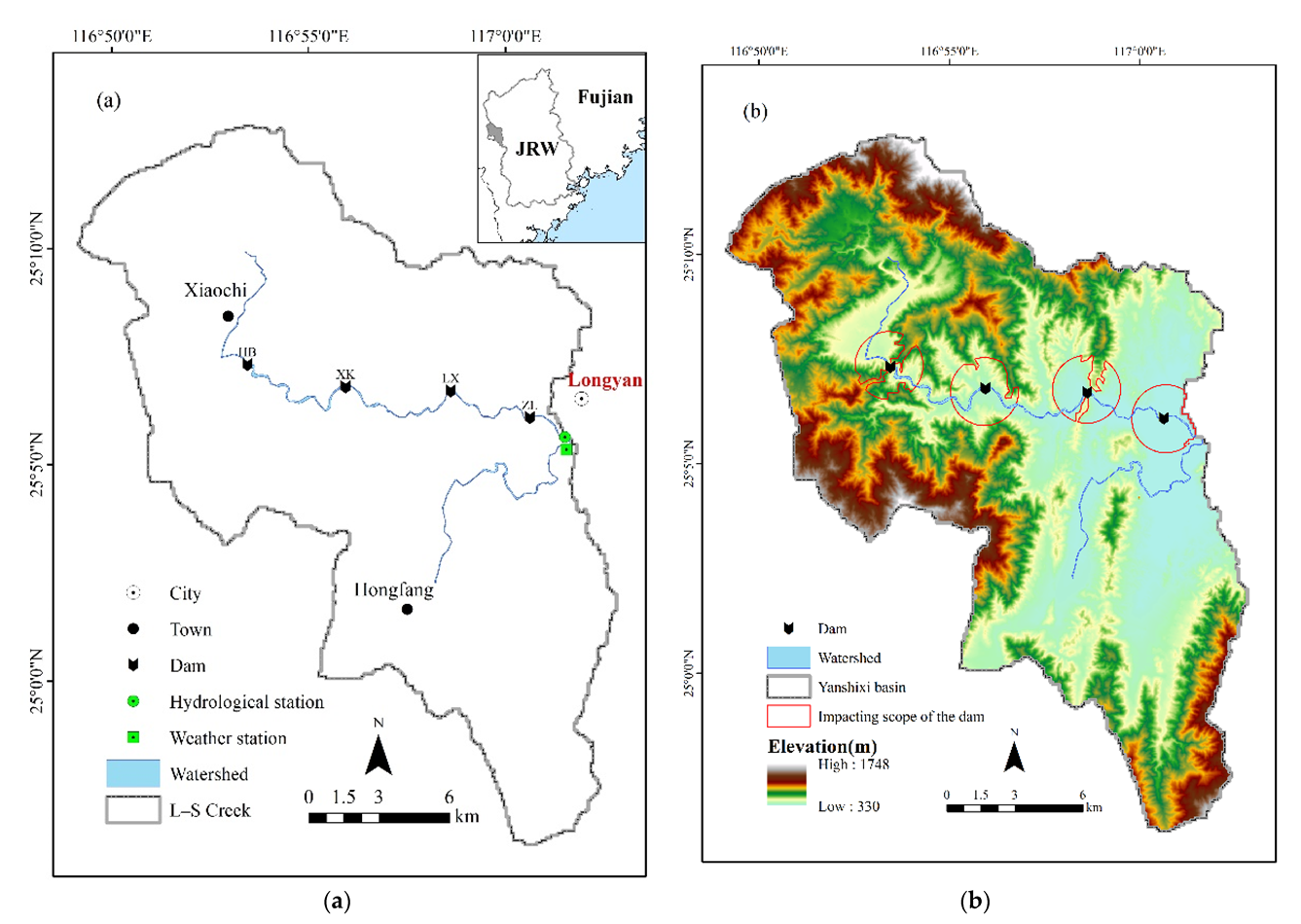

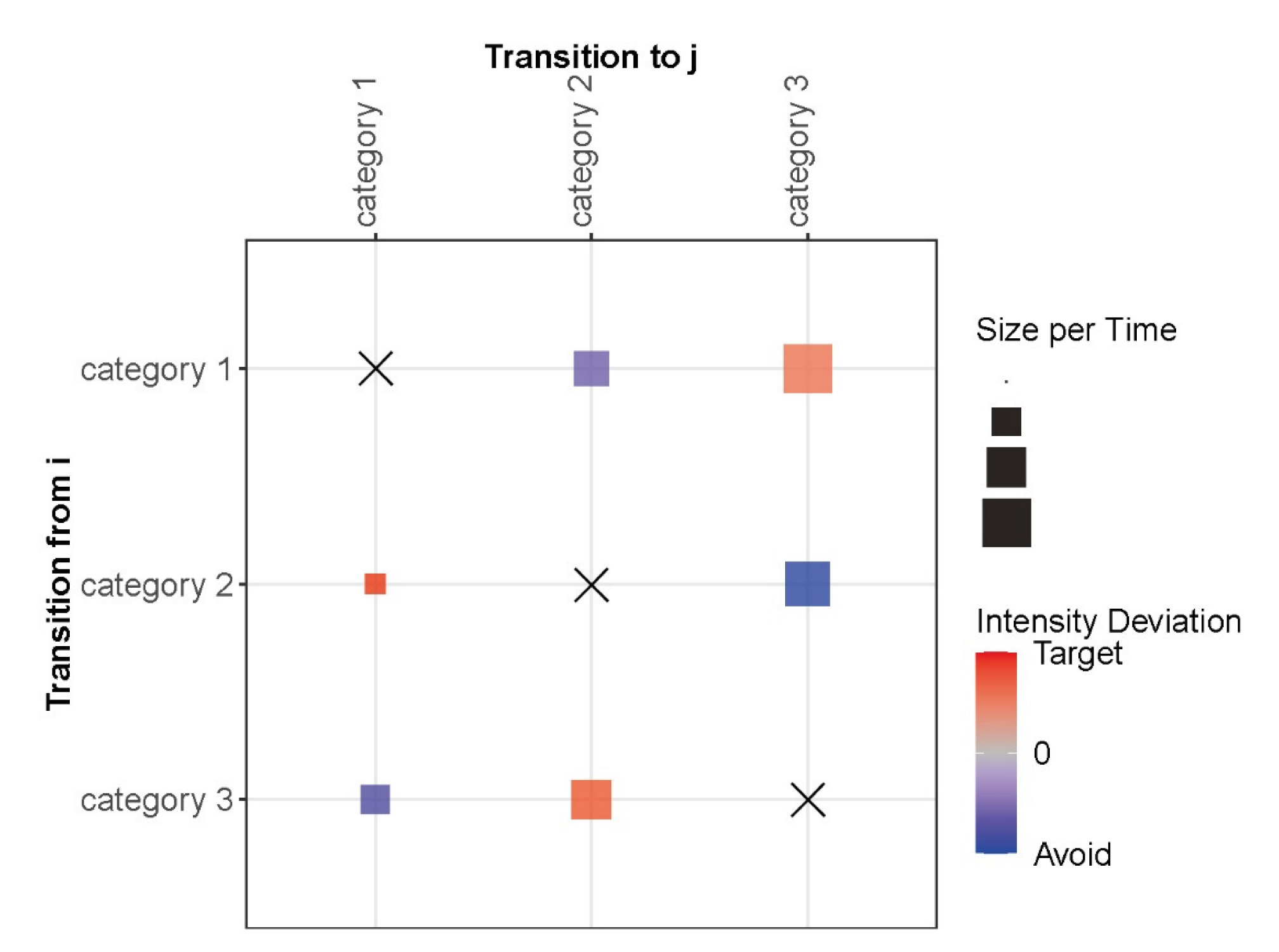

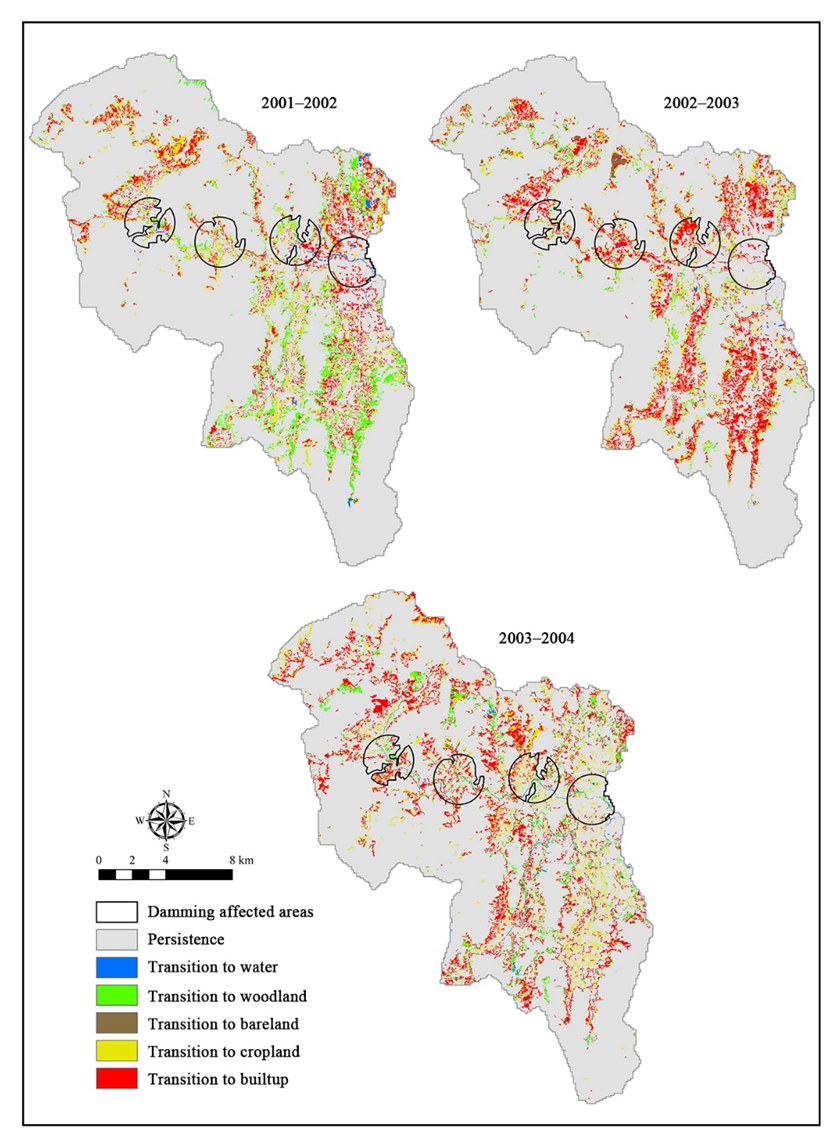
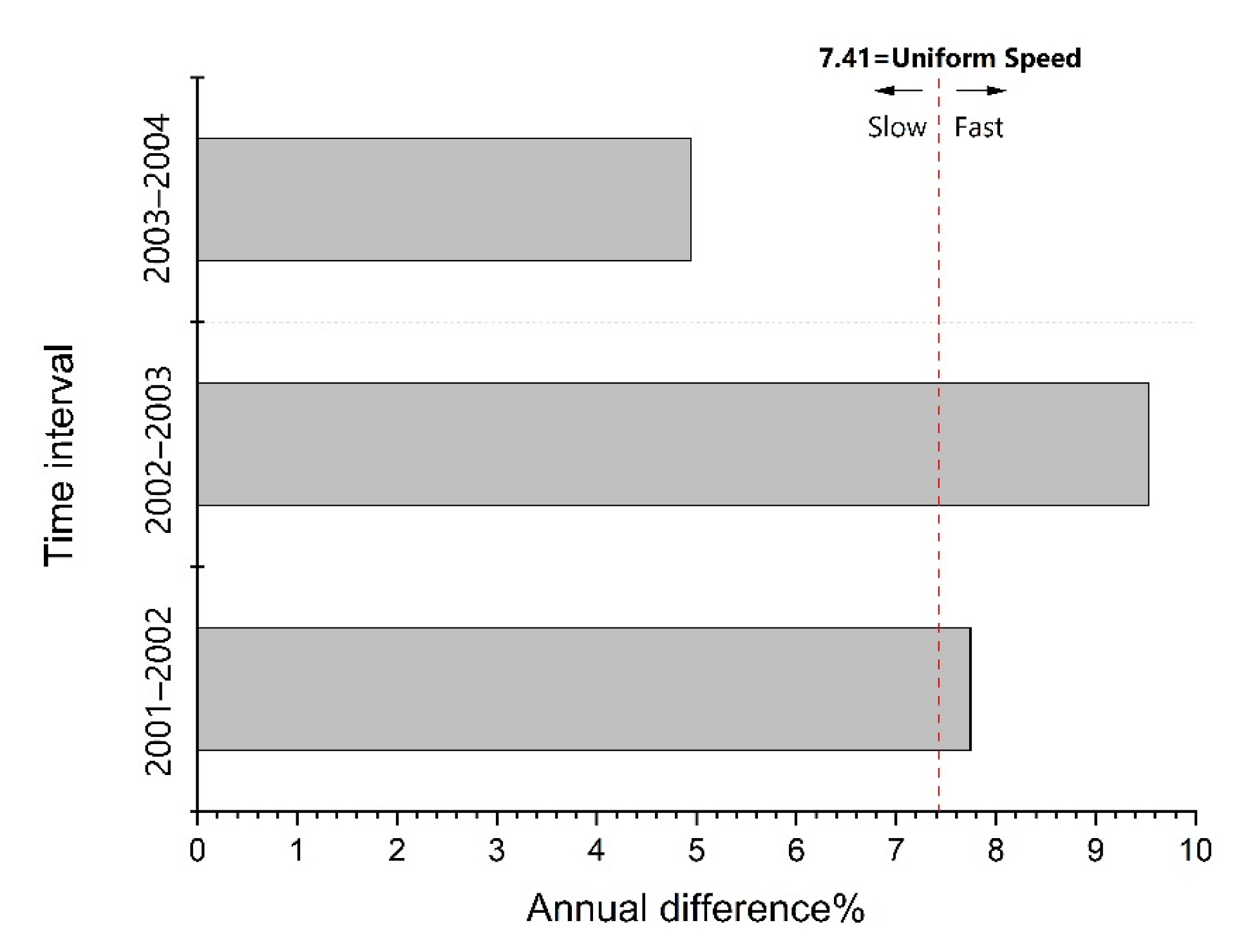
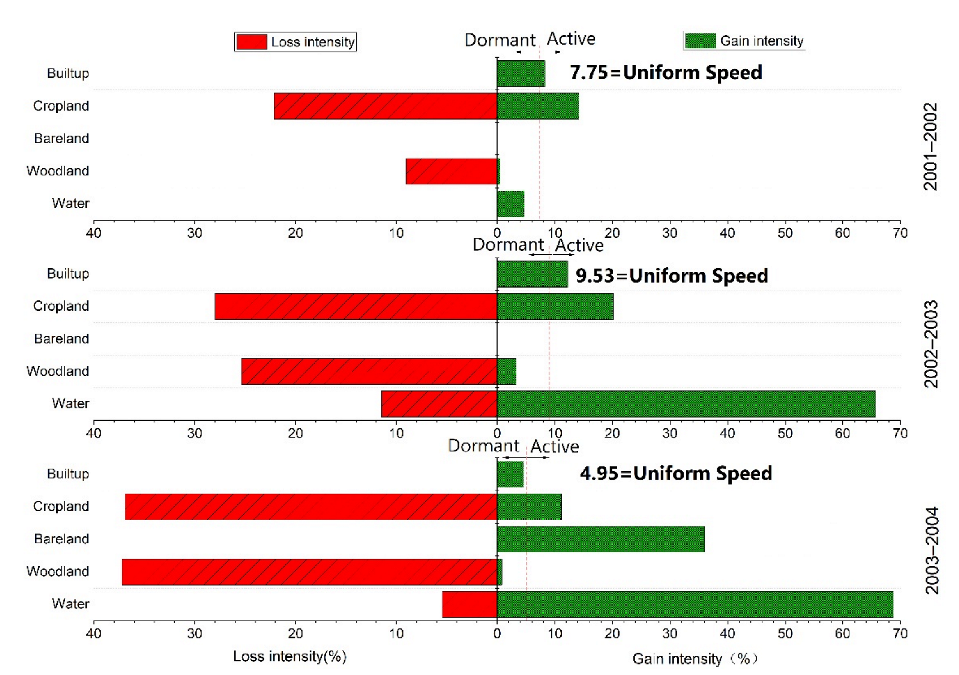


| Name | Capacity (103 m3) | Drainage Area (km2) | Type | Construction Year |
|---|---|---|---|---|
| Hejiabi (HB) | 195.5 | 0.8 | Flood Dam | 2003 |
| Xikengkou (XK) | 82 | 0.4 | Hydropower Dam | 2003 |
| Longmenxi (LX) | 27.4 | 0.2 | Hydropower Dam | 2003 |
| Zhaolong (ZL) | 82 | 0.5 | Hydropower Dam | 2003 |
| ED | LSI | LPI | CONTAG | SHDI | ||||||
|---|---|---|---|---|---|---|---|---|---|---|
| Outside | Inside | Outside | Inside | Outside | Inside | Outside | Inside | Outside | Inside | |
| 2001 | 61.23 | 119.35 | 31.13 | 18.24 | 54.94 | 20.04 | 70.25 | 59.31 | 0.76 | 1.10 |
| 2002 | 63.31 | 103.42 | 32.10 | 16.27 | 54.51 | 22.57 | 71.07 | 48.17 | 0.74 | 1.11 |
| 2003 | 55.59 | 92.23 | 28.52 | 14.88 | 52.40 | 23.35 | 70.43 | 62.22 | 0.77 | 0.94 |
| 2004 | 65.42 | 122.66 | 33.08 | 18.65 | 47.60 | 21.40 | 71.56 | 62.22 | 0.81 | 0.99 |
| ED | LSI | LPI | AREA_MN | IJI | |||||||
|---|---|---|---|---|---|---|---|---|---|---|---|
| LID | TYPE | Outside | Inside | Outside | Inside | Outside | Inside | Outside | Inside | Outside | Inside |
| 2001 | Water | 2.39 | 16.35 | 25.17 | 18.96 | 0.08 | 0.36 | 2.00 | 3.46 | 64.95 | 52.28 |
| Woodland | 30.02 | 43.10 | 18.64 | 12.55 | 54.94 | 11.62 | 173.02 | 16.85 | 61.18 | 55.61 | |
| Bareland | 0.82 | 0.37 | 9.58 | 2.14 | 0.02 | 0.02 | 1.39 | 0.54 | 10.88 | 36.03 | |
| Cropland | 43.64 | 84.86 | 60.63 | 24.90 | 1.74 | 3.22 | 5.68 | 2.88 | 50.12 | 43.01 | |
| Builtup | 45.59 | 94.03 | 57.68 | 19.06 | 7.14 | 20.04 | 8.59 | 14.00 | 55.18 | 53.50 | |
| 2002 | Water | 2.76 | 19.25 | 21.73 | 14.83 | 0.11 | 0.88 | 2.55 | 4.09 | 74.08 | 76.77 |
| Woodland | 32.36 | 40.96 | 19.73 | 12.11 | 54.51 | 8.87 | 114.02 | 17.19 | 52.66 | 69.87 | |
| Bareland | 0.02 | - | 1.39 | - | 0.01 | - | 1.82 | - | 66.56 | - | |
| Cropland | 50.42 | 76.86 | 77.58 | 24.82 | 0.46 | 3.21 | 2.97 | 3.06 | 53.68 | 78.45 | |
| Builtup | 41.05 | 69.77 | 50.42 | 14.14 | 6.25 | 22.57 | 10.54 | 22.90 | 51.74 | 81.84 | |
| 2003 | Water | 2.64 | 17.22 | 23.45 | 18.53 | 0.08 | 0.46 | 2.22 | 2.33 | 51.87 | 31.29 |
| Woodland | 27.72 | 35.31 | 17.64 | 11.44 | 52.40 | 9.04 | 218.02 | 22.47 | 58.55 | 55.30 | |
| Bareland | 1.19 | - | 9.82 | - | 0.15 | - | 3.35 | - | 76.23 | - | |
| Cropland | 40.89 | 59.09 | 78.35 | 27.18 | 0.13 | 0.27 | 1.62 | 1.07 | 52.93 | 51.31 | |
| Builtup | 38.74 | 72.86 | 39.57 | 13.24 | 7.95 | 23.35 | 21.51 | 54.27 | 61.74 | 71.86 | |
| 2004 | Water | 2.85 | 16.41 | 19.77 | 14.20 | 0.15 | 0.66 | 3.01 | 5.68 | 52.30 | 46.33 |
| Woodland | 38.40 | 54.93 | 23.78 | 16.22 | 47.60 | 4.42 | 83.61 | 6.56 | 48.26 | 48.54 | |
| Bareland | 2.95 | 4.73 | 21.81 | 7.18 | 0.01 | 0.10 | 0.71 | 0.86 | 60.50 | 61.66 | |
| Cropland | 30.45 | 60.58 | 67.72 | 26.99 | 0.09 | 0.35 | 1.16 | 0.94 | 36.73 | 26.38 | |
| Builtup | 55.73 | 108.68 | 50.91 | 19.00 | 8.03 | 21.40 | 20.43 | 39.44 | 55.87 | 62.89 | |
Publisher’s Note: MDPI stays neutral with regard to jurisdictional claims in published maps and institutional affiliations. |
© 2022 by the authors. Licensee MDPI, Basel, Switzerland. This article is an open access article distributed under the terms and conditions of the Creative Commons Attribution (CC BY) license (https://creativecommons.org/licenses/by/4.0/).
Share and Cite
Xie, Z.; Liu, J.; Huang, J.; Chen, Z.; Lu, X. Linking Land Cover Change with Landscape Pattern Dynamics Induced by Damming in a Small Watershed. Remote Sens. 2022, 14, 3580. https://doi.org/10.3390/rs14153580
Xie Z, Liu J, Huang J, Chen Z, Lu X. Linking Land Cover Change with Landscape Pattern Dynamics Induced by Damming in a Small Watershed. Remote Sensing. 2022; 14(15):3580. https://doi.org/10.3390/rs14153580
Chicago/Turabian StyleXie, Zheyu, Jihui Liu, Jinliang Huang, Zilong Chen, and Xixi Lu. 2022. "Linking Land Cover Change with Landscape Pattern Dynamics Induced by Damming in a Small Watershed" Remote Sensing 14, no. 15: 3580. https://doi.org/10.3390/rs14153580
APA StyleXie, Z., Liu, J., Huang, J., Chen, Z., & Lu, X. (2022). Linking Land Cover Change with Landscape Pattern Dynamics Induced by Damming in a Small Watershed. Remote Sensing, 14(15), 3580. https://doi.org/10.3390/rs14153580





